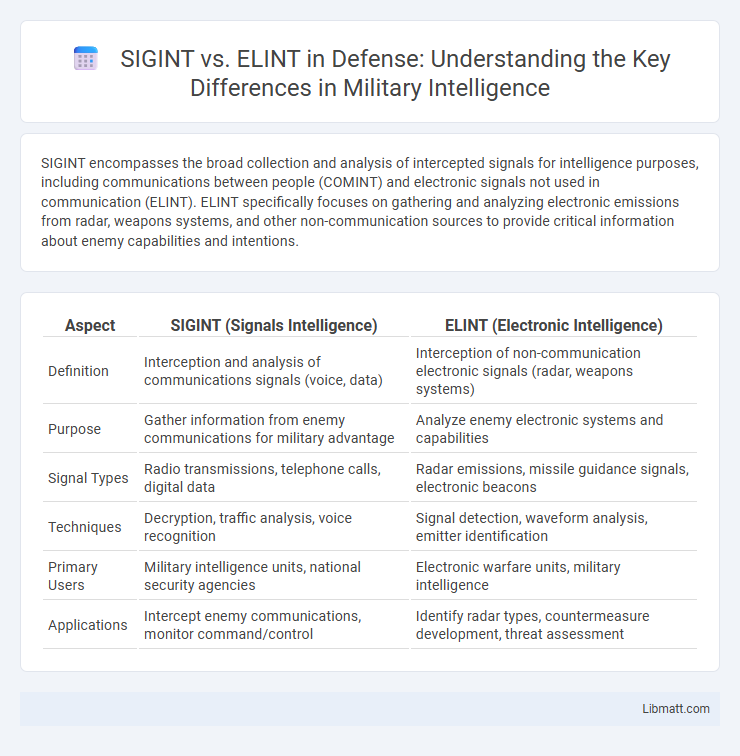SIGINT encompasses the broad collection and analysis of intercepted signals for intelligence purposes, including communications between people (COMINT) and electronic signals not used in communication (ELINT). ELINT specifically focuses on gathering and analyzing electronic emissions from radar, weapons systems, and other non-communication sources to provide critical information about enemy capabilities and intentions.
Table of Comparison
| Aspect | SIGINT (Signals Intelligence) | ELINT (Electronic Intelligence) |
|---|---|---|
| Definition | Interception and analysis of communications signals (voice, data) | Interception of non-communication electronic signals (radar, weapons systems) |
| Purpose | Gather information from enemy communications for military advantage | Analyze enemy electronic systems and capabilities |
| Signal Types | Radio transmissions, telephone calls, digital data | Radar emissions, missile guidance signals, electronic beacons |
| Techniques | Decryption, traffic analysis, voice recognition | Signal detection, waveform analysis, emitter identification |
| Primary Users | Military intelligence units, national security agencies | Electronic warfare units, military intelligence |
| Applications | Intercept enemy communications, monitor command/control | Identify radar types, countermeasure development, threat assessment |
Introduction to SIGINT and ELINT
Signals Intelligence (SIGINT) encompasses the collection and analysis of electronic signals for intelligence purposes, including communications intelligence (COMINT) and electronic intelligence (ELINT). ELINT specifically targets non-communication electronic emissions, such as radar and weapons systems, to gather tactical and strategic information. Both SIGINT and ELINT play critical roles in military and national security operations by providing insights into enemy capabilities and intentions.
Defining SIGINT: An Overview
SIGINT, or Signals Intelligence, encompasses the interception and analysis of electronic signals for intelligence purposes, including communications between people and electronic signals not used in communication. ELINT, a subset of SIGINT, specifically targets electronic emissions from non-communication sources like radar systems to gather information on enemy radar capabilities and operational locations. You can leverage SIGINT to obtain comprehensive intelligence on adversaries' communication patterns and electronic systems.
Understanding ELINT: Key Concepts
ELINT, or Electronic Intelligence, involves the interception and analysis of non-communication electronic signals emitted by radar and other electronic systems to gather strategic information. Unlike SIGINT, which encompasses a broader spectrum of signals including communications, ELINT specifically targets electronic emissions that reveal technical details about enemy radar capabilities, frequencies, and signal patterns. Your ability to analyze these electronic signatures enhances situational awareness and supports effective electronic warfare tactics.
Historical Evolution of SIGINT and ELINT
SIGINT (Signals Intelligence) originated during World War I with the interception of encrypted communications, evolving significantly through World War II with the development of codebreaking technologies such as the Enigma machine decryption. ELINT (Electronic Intelligence) emerged in the Cold War era, driven by advancements in radar and electronic signal detection used primarily to analyze enemy radar and communication systems. The historical evolution of SIGINT and ELINT reflects the increasing sophistication of electronic warfare and intelligence gathering from basic interception to complex signal analysis and electronic spectrum exploitation.
Core Components and Technologies Involved
SIGINT (Signals Intelligence) primarily involves intercepting communications and electronic signals, utilizing core components such as antennas, receivers, and signal processors designed for broad spectrum analysis. ELINT (Electronic Intelligence) focuses specifically on non-communication electronic emissions like radar signals, relying on advanced radar detection systems, direction-finding equipment, and electronic warfare technologies to gather tactical data. Your understanding of these differences highlights how SIGINT targets communication signals while ELINT concentrates on electronic signal sources to support situational awareness and threat identification.
Differences Between SIGINT and ELINT
SIGINT (Signals Intelligence) encompasses the interception and analysis of all types of electronic signals, including communication signals (COMINT) and electronic signals (ELINT). ELINT (Electronic Intelligence) specifically targets non-communication electronic emissions such as radar, missile guidance, and navigation signals to gather intelligence about enemy capabilities and intentions. Your understanding of SIGINT and ELINT differences is crucial for applications in defense and intelligence analysis.
Applications in Military and Intelligence Operations
SIGINT (Signals Intelligence) encompasses the interception and analysis of all electronic signals, including communications and radar emissions, to gather critical information on enemy intentions and movements. ELINT (Electronic Intelligence), a subset of SIGINT, specifically targets non-communication electronic signals such as radar and weapons systems to identify, track, and neutralize hostile threats. Military and intelligence operations leverage SIGINT for battlefield awareness and strategic planning, while ELINT provides technical data essential for electronic warfare, threat detection, and countermeasure development.
Challenges in SIGINT and ELINT Collection
SIGINT faces challenges such as encryption, signal obfuscation, and massive data volumes that complicate accurate interception and analysis. ELINT collection struggles with detecting and identifying radar signals amid cluttered electromagnetic environments and requires advanced technology to differentiate between friendly and hostile emissions. Your efforts to enhance intelligence rely on overcoming these obstacles with cutting-edge signal processing and machine learning techniques.
Future Trends in Signals and Electronic Intelligence
Future trends in SIGINT (Signals Intelligence) and ELINT (Electronic Intelligence) emphasize the integration of artificial intelligence and machine learning to enhance data analysis and threat detection. Advanced cyber capabilities and quantum computing are expected to revolutionize signal interception and electronic surveillance, making intelligence gathering faster and more precise. Your defense systems must adapt to growing electronic warfare complexity, leveraging real-time processing and autonomous signal classification to maintain strategic advantage.
Conclusion: The Strategic Value of SIGINT vs ELINT
SIGINT provides comprehensive intelligence by intercepting all types of electronic communications, offering broad situational awareness critical for strategic decision-making. ELINT focuses specifically on non-communication electronic signals, enabling the identification and location of radar and missile systems, which is vital for electronic warfare and threat assessment. Together, SIGINT and ELINT form a complementary intelligence framework that enhances national security by delivering both wide-ranging communication data and precise electronic emissions analysis.
SIGINT vs ELINT Infographic

 libmatt.com
libmatt.com